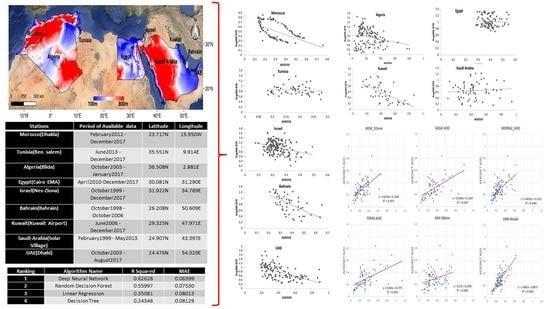Urban Health Related Air Quality Indicators over the Middle East and North Africa Countries Using Multiple Satellites and AERONET Data
Abstract
:1. Introduction
2. Materials and Methods
2.1. Study Area
2.2. TROPOMI Sentilnel-5P Dataset
2.3. AERONET Data Measurement
2.4. Modeling of AOD Using Satellite and Ground-Based Datasets
3. Results
3.1. Comparision of Air Pollutant Components among Differences Regions within Urban Cairo Area
3.2. Seasonal Air Polluant Climatology Distribution over MENA Region Using Sentinel 5P TROPOMI and MERRA-2 AOD Products
3.3. Annual Air Polluant Distribution over the Selected Countries Using Sentinel 5P TROPOMI Product
3.4. Spatial Variability and Properties of Aerosol over the Selected Countries
3.5. Modeling of the MENA Aerosol Products
4. Discussion
5. Conclusions
Author Contributions
Funding
Acknowledgments
Conflicts of Interest
References
- WHO. Urban Air Pollution Database; WHO: Geneva, Switzerland, 2016. [Google Scholar]
- AFED. Arab Environment in 10 Years. Annual Report of Arab Forum for Environment and Development; Saab, N., Ed.; AFED: Beirut, Lebanon, 2017. [Google Scholar]
- Ramsey, L. Business Insider. May 2016. Available online: http://www.businessinsider.com/the-cities-with-the-worlds-worst-air-pollution-who-2016-5 (accessed on 15 June 2019).
- World Bank. The Little Green Data Book 2016; The World Bank: Washington, DC, USA, 2016; ISBN 978-1-4648-0928-6. [Google Scholar]
- AFED; Chaaban, F.B. Air Quality, Arab Forum for Environment and Development (AFED). Arab Environment; Future Challenges; AFED: Bejrut, Lebanon, 2008. [Google Scholar]
- Sami, S.; Khonji, T. Traffic Blamed for Air Pollution in Bahrain; Daily Gulf News: Dubai, UAE, 2006. [Google Scholar]
- GHG Equivalence Calculator, USEPA. Available online: www.epa.gov/energy (accessed on 15 June 2019).
- MadaMasr Study. Air pollution kills 35,000 a year in Egypt, with dust the biggest culprit. 21 September 2015. Available online: http://www.madamasr.com/en/2015/09/21/news/u/study-air-pollution-kills-35000-a-year-in- egypt-with-dust-the-biggest-culprit/ (accessed on 15 June 2019).
- Abdalla, K. Health and Environmental Benefits of Clean Fuels and Vehicles; UN DESA: Cairo, Egypt, 2006. [Google Scholar]
- Aboel Fetouh, Y.; El Askary, H.; El Raey, M.; Allali, M.; Sprigg, W.A.; Kafatos, M. Annual patterns of atmospheric pollutions and episodes over Cairo Egypt. Adv. Meteorol. 2013, 2013, 1–11. [Google Scholar] [CrossRef]
- IPCC Report. The Fourth Assessment Report (AR4). Available online: http:/www.ipcc.ch/ (accessed on 14 March 2008).
- Thalib, L.; Al-Taiar, A. Dust storms and the risk of asthma admissions to hospitals in Kuwait. Sci. Total. Environ. 2012, 433, 347–351. [Google Scholar] [CrossRef] [PubMed]
- Bousquet, J.; Ndiaye, M.; Aït-Khaled, N.; Annesi-Maesano, I.; Vignola, A.-M. Management of chronic respiratory and allergic diseases in developing countries. Focus on sub-Saharan Africa. Allergy 2003, 58, 265–283. [Google Scholar] [CrossRef] [PubMed]
- Levelt, P.F.; Hilsenrath, E.; Leppelmeier, G.W.; van den Oord, G.H.J.; Bhartia, P.K.; Tamminen, J.; de Haan, J.F.; Veefkind, J.P. Science objectives of the ozone monitoring instrument. IEEE Trans. Geosci. Remote Sens. 2006, 44, 1199–1208. [Google Scholar] [CrossRef]
- Levelt, P.F.; van den Oord, G.H.J.; Dobber, M.R.; Malkki, A.; Visser, H.; de Johan, V.; Stammes, P.; Lundell, J.O.V.; Saari, H. The ozone monitoring instrument. IEEE Trans. Geosci. Remote Sens. 2006, 44, 1093–1101. [Google Scholar] [CrossRef]
- Astitha, M.; Lelieveld, J.; Abdel Kader, M.; Pozzer, A.; de Meij, A. Parameterization of dust emissions in the global atmospheric chemistry-climate model EMAC: Impact of nudging and soil properties. Atmos. Chem. Phys. 2012, 12, 11057–11083. [Google Scholar] [CrossRef]
- Hsu, N.C.; Gautam, R.; Sayer, A.M.; Bettenhausen, C.; Li, C.; Jeong, M.J.; Tsay, S.-C.; Holben, B.N. Global and regional trends of aerosol optical depth over land and ocean using SeaWiFS measurements from 1997 to 2010. Atmos. Chem. Phys. 2012, 12, 8037–8053. [Google Scholar] [CrossRef] [Green Version]
- Todd, M.C.; Washington, R.; Martins, J.V.; Dubovik, O.; Lizcano, G.; M’Bainayel, S.; Engelstaedter, S. Mineral dust emission from the Bodélé Depression, Northern Chad, during BoDEx 2005. J. Geophys. Res. 2007, 112. [Google Scholar] [CrossRef]
- Baker, A.R.; Croot, P.L. Atmospheric and marine controls on aerosol iron solubility in seawater. Mar. Chem. 2010, 120, 4–13. [Google Scholar] [CrossRef]
- Schladitz, A.; Müller, T.; Nowak, A.; Kandler, K.; Lieke, K.; Massling, A.; Wiedensohler, A. In situ aerosol characterization at Cape Verde: Part 1: Particle number size distributions, hygroscopic growth and state of mixing of the marine and Saharan dust aerosol. Tellus B Chem. Phys. Meteorol. 2011, 63, 531–548. [Google Scholar] [CrossRef]
- Sadiq, M.; McCain, J.C. (Eds.) The Gulf War Aftermath; Environment & Assessment; Springer Netherlands: Dordrecht, The Netherlands, 1993; Volume 4, ISBN 978-94-010-4737-1. [Google Scholar]
- Farahat, A. Air pollution in the Arabian Peninsula (Saudi Arabia, the UAE, Kuwait, Qatar, Bahrain, and Oman): Causes, effects, and aerosol categorization. Arab. J. Geosci. 2016, 9, 196. [Google Scholar] [CrossRef]
- Chin, M.; Diehl, T.; Tan, Q.; Prospero, J.M.; Kahn, R.A.; Remer, L.A.; Yu, H.; Sayer, A.M.; Bian, H.; Geogdzhayev, I.V.; et al. Multi-decadal aerosol variations from 1980 to 2009: A perspective from observations and a global model. Atmos. Chem. Phys. 2014, 14, 3657–3690. [Google Scholar] [CrossRef]
- Ramanathan, V.; Cess, R.D.; Harrison, E.F.; Minnis, P.; Barkstrom, B.R.; Ahmad, E.; Hartmann, D. Cloud-radiative forcing and climate: Results from the earth radiation budget experiment. Science 1989, 243, 57–63. [Google Scholar] [CrossRef] [PubMed]
- Satheesh, S.; Krishnamoorthy, K. Radiative effects of natural aerosols: A review. Atmos. Environ. 2005, 39, 2089–2110. [Google Scholar] [CrossRef]
- Farahat, A.; El-Askary, H.; Al-Shaibani, A. Study of aerosols’ characteristics and dynamics over the Kingdom of Saudi Arabia using a multisensor approach combined with ground observations. Adv. Meteorol. 2015, 2015, 1–12. [Google Scholar] [CrossRef]
- El-Askary, H.; Farouk, R.; Ichoku, C.; Kafatos, M. Transport of dust and anthropogenic aerosols across Alexandria, Egypt. Ann. Geophys. 2009, 27, 2869–2879. [Google Scholar] [CrossRef] [Green Version]
- Ansmann, A.; Seifert, P.; Tesche, M.; Wandinger, U. Profiling of fine and coarse particle mass: Case studies of Saharan dust and Eyjafjallajökull/Grimsvötn volcanic plumes. Atmos. Chem. Phys. 2012, 12, 9399–9415. [Google Scholar] [CrossRef]
- Yu, Y.; Notaro, M.; Liu, Z.; Wang, F.; Alkolibi, F.; Fadda, E.; Bakhrjy, F. Climatic controls on the interannual to decadal variability in Saudi Arabian dust activity: Toward the development of a seasonal dust prediction model: Saudi Arabian dust prediction. J. Geophys. Res. Atmos. 2015, 120, 1739–1758. [Google Scholar] [CrossRef]
- Farahat, A.; El-Askary, H.; Dogan, A.U. Aerosols size distribution characteristics and role of precipitation during dust storm formation over Saudi Arabia. Aerosol. Air Qual. Res. 2016, 16, 2523–2534. [Google Scholar] [CrossRef]
- Solomos, S.; Ansmann, A.; Mamouri, R.-E.; Binietoglou, I.; Patlakas, P.; Marinou, E.; Amiridis, V. Remote sensing and modelling analysis of the extreme dust storm hitting the Middle East and eastern Mediterranean in September 2015. Atmos. Chem. Phys. 2017, 17, 4063–4079. [Google Scholar] [CrossRef] [Green Version]
- Ginoux, P.; Chin, M.; Tegen, I.; Prospero, J.M.; Holben, B.; Dubovik, O.; Lin, S.-J. Sources and distributions of dust aerosols simulated with the GOCART model. J. Geophys. Res. Atmos. 2001, 106, 20255–20273. [Google Scholar] [CrossRef]
- Kim, D.; Chin, M.; Yu, H.; Eck, T.F.; Sinyuk, A.; Smirnov, A.; Holben, B.N. Dust optical properties over North Africa and Arabian Peninsula derived from the AERONET dataset. Atmos. Chem. Phys. 2011, 11, 10733–10741. [Google Scholar] [CrossRef] [Green Version]
- Rockström, J.; Steffen, W.L.; Noone, K.; Persson, Å.; Chapin, F.S., III; Lambin, E.; Nykvist, B. Planetary boundaries: Exploring the safe operating space for humanity. Ecol. Soc. 2009, 14, 32. [Google Scholar] [CrossRef]
- Vörösmarty, C.J.; McIntyre, P.B.; Gessner, M.O.; Dudgeon, D.; Prusevich, A.; Green, P.; Glidden, S.; Bunn, S.E.; Sullivan, C.A.; Liermann, C.R.; et al. Global threats to human water security and river biodiversity. Nature 2010, 467, 555–561. [Google Scholar] [CrossRef] [PubMed]
- Droogers, P.; de Boer, F.; Terink, W. Water allocation models for the Umbeluzi River Basin, Mozambique. In Wetter Skip Frystan and ARA-Sul Report Future Water; ARA-Sul: Maputo, Mozambique, 2014; Volume 132. [Google Scholar]
- Veefkind, J.P.; Aben, I.; McMullan, K.; Förster, H.; de Vries, J.; Otter, G.; Claas, J.; Eskes, H.J.; de Haan, J.F.; Kleipool, Q.; et al. TROPOMI on the ESA Sentinel-5 Precursor: A GMES mission for global observations of the atmospheric composition for climate, air quality and ozone layer applications. Remote Sens. Environ. 2012, 120, 70–83. [Google Scholar] [CrossRef]
- Gorelick, N.; Hancher, M.; Dixon, M.; Ilyushchenko, S.; Thau, D.; Moore, R. Google earth engine: Planetary-scale geospatial analysis for everyone. Remote Sens. Environ. 2017, 202, 18–27. [Google Scholar] [CrossRef]
- Li, W.; El-Askary, H.M.; Qurban, M.; Allali, M.; Manikandan, K.P. On the drying trends over the MENA countries using harmonic analysis of the enhanced vegetation index. In Advances in Remote Sensing and Geo Informatics Applications; El-Askary, H.M., Lee, S., Heggy, E., Pradhan, B., Eds.; Springer International Publishing: Cham, Switzerland, 2019; pp. 243–245. ISBN 978-3-030-01439-1. [Google Scholar]
- El-Askary, H.M.; Li, W.; El-Nadry, M.; Awad, M.; Mostafa, A.R. Strong interactions indicated between dust aerosols and precipitation related clouds in the Nile Delta. In Advances in Remote Sensing and Geo Informatics Applications; El-Askary, H.M., Lee, S., Heggy, E., Pradhan, B., Eds.; Springer International Publishing: Cham, Switzerland, 2019; pp. 3–6. ISBN 978-3-030-01439-1. [Google Scholar]
- Li, W.; El-Askary, H.; Qurban, M.A.; Li, J.; ManiKandan, K.P.; Piechota, T. Using multi-indices approach to quantify mangrove changes over the Western Arabian Gulf along Saudi Arabia coast. Ecol. Indic. 2019, 102, 734–745. [Google Scholar] [CrossRef]
- Holben, B.N.; Eck, T.F.; Slutsker, I.; Tanré, D.; Buis, J.P.; Setzer, A.; Vermote, E.; Reagan, J.A.; Kaufman, Y.J.; Nakajima, T.; et al. AERONET—A federated instrument network and data archive for aerosol characterization. Remote Sens. Environ. 1998, 66, 1–16. [Google Scholar] [CrossRef]
- Smirnov, A.; Holben, B.N.; Eck, T.F.; Dubovik, O.; Slutsker, I. Cloud-screening and quality control algorithms for the AERONET database. Remote Sens. Environ. 2000, 73, 337–349. [Google Scholar] [CrossRef]
- Dubovik, O.; Smirnov, A.; Holben, B.N.; King, M.D.; Kaufman, Y.J.; Eck, T.F.; Slutsker, I. Accuracy assessments of aerosol optical properties retrieved from aerosol robotic network (AERONET) sun and sky radiance measurements. J. Geophys. Res. Atmos. 2000, 105, 9791–9806. [Google Scholar] [CrossRef]
- Smirnov, A.; Holben, B.N.; Kaufman, Y.J.; Dubovik, O.; Eck, T.F.; Slutsker, I.; Pietras, C.; Halthore, R.N. Optical properties of atmospheric aerosol in maritime environments. J. Atmos. Sci. 2002, 59, 501–523. [Google Scholar] [CrossRef]
- Kahn, R.A. Multiangle imaging spectroradiometer (MISR) global aerosol optical depth validation based on 2 years of coincident aerosol robotic network (AERONET) observations. J. Geophys. Res. 2005, 110. [Google Scholar] [CrossRef]
- Kokhanovsky, A.A.; Breon, F.-M.; Cacciari, A.; Carboni, E.; Diner, D.; Di Nicolantonio, W.; Grainger, R.G.; Grey, W.M.F.; Höller, R.; Lee, K.-H.; et al. Aerosol remote sensing over land: A comparison of satellite retrievals using different algorithms and instruments. Atmos. Res. 2007, 85, 372–394. [Google Scholar] [CrossRef]
- Liu, L.; Mishchenko, M.I. Toward unified satellite climatology of aerosol properties: Direct comparisons of advanced level 2 aerosol products. J. Quant. Spectrosc. Radiat. Transf. 2008, 109, 2376–2385. [Google Scholar] [CrossRef]
- Mishchenko, M.I.; Geogdzhayev, I.V.; Liu, L.; Lacis, A.A.; Cairns, B.; Travis, L.D. Toward unified satellite climatology of aerosol properties: What do fully compatible MODIS and MISR aerosol pixels tell us? J. Quant. Spectrosc. Radiat. Transf. 2009, 110, 402–408. [Google Scholar] [CrossRef]
- Chin, M. Atmospheric Aerosol Properties and Climate Impacts; Diane Publishing: Collingdale, PA, USA, 2009. [Google Scholar]
- Marey, H.S.; Gille, J.C.; El-Askary, H.M.; Shalaby, E.A.; El-Raey, M.E. Study of the formation of the black cloud and its dynamics over Cairo, Egypt, using MODIS and MISR sensors. J. Geophys. Res. 2010, 115. [Google Scholar] [CrossRef]
- Kahn, R.A.; Gaitley, B.J.; Garay, M.J.; Diner, D.J.; Eck, T.F.; Smirnov, A.; Holben, B.N. Multiangle imaging spectroradiometer global aerosol product assessment by comparison with the Aerosol Robotic Network. J. Geophys. Res. 2010, 115. [Google Scholar] [CrossRef]
- Kaufman, Y.J.; Tanré, D.; Remer, L.A.; Vermote, E.F.; Chu, A.; Holben, B.N. Operational remote sensing of tropospheric aerosol over land from EOS moderate resolution imaging spectroradiometer. J. Geophys. Res. Atmos. 1997, 102, 17051–17067. [Google Scholar] [CrossRef]
- Remer, L.A.; Kaufman, Y.J.; Tanré, D.; Mattoo, S.; Chu, D.A.; Martins, J.V.; Li, R.-R.; Ichoku, C.; Levy, R.C.; Kleidman, R.G.; et al. The MODIS aerosol algorithm, products, and validation. J. Atmos. Sci. 2005, 62, 947–973. [Google Scholar] [CrossRef]
- Mishchenko, M.I.; Geogdzhayev, I.V. Satellite remote sensing reveals regional tropospheric aerosol trends. Opt. Express 2007, 15, 7423. [Google Scholar] [CrossRef]
- Just, A.; De Carli, M.; Shtein, A.; Dorman, M.; Lyapustin, A.; Kloog, I. Correcting measurement error in satellite aerosol optical depth with machine learning for modeling PM2.5 in the Northeastern USA. Remote Sens. 2018, 10, 803. [Google Scholar] [CrossRef]
- Lanzaco, B.L.; Olcese, L.E.; Palancar, G.G.; Toselli, B.M. An improved aerosol optical depth map based on machine-learning and MODIS data: Development and application in South America. Aerosol Air Qual. Res. 2017, 17, 1623–1636. [Google Scholar] [CrossRef]
- Qin, W.; Wang, L.; Lin, A.; Zhang, M.; Bilal, M. Improving the estimation of daily aerosol optical depth and aerosol radiative effect using an optimized artificial neural network. Remote Sens. 2018, 10, 1022. [Google Scholar] [CrossRef]
- García, R.D.; García, O.E.; Cuevas, E.; Cachorro, V.E.; Barreto, A.; Guirado-Fuentes, C.; Kouremeti, N.; Bustos, J.J.; Romero-Campos, P.M.; de Frutos, A.M. Aerosol optical depth retrievals at the Izaña atmospheric observatory from 1941 to 2013 by using artificial neural networks. Atmos. Meas. Tech. 2016, 9, 53–62. [Google Scholar] [CrossRef]
- Hutter, F.; Hoos, H.H.; Leyton-Brown, K. Sequential model-based optimization for general algorithm configuration. In Learning and Intelligent Optimization; Coello, C.A.C., Ed.; Springer: Berlin/Heidelberg, Germany, 2011; Volume 6683, pp. 507–523. ISBN 978-3-642-25565-6. [Google Scholar]
- Xu, Q.-S.; Liang, Y.-Z. Monte Carlo cross validation. Chemom. Intell. Lab. Syst. 2001, 56, 1–11. [Google Scholar] [CrossRef]
- Breiman, L. Bagging predictors. Mach. Learn. 1996, 24, 123–140. [Google Scholar] [CrossRef] [Green Version]
- Tin, K.H. Random decision forests. In Proceedings of the 3rd International Conference on Document Analysis and Recognition, Montreal, QC, Canada, 14–16 August 1995; Volume 1, pp. 278–282. [Google Scholar]
- Neu, J.L.; Flury, T.; Manney, G.L.; Santee, M.L.; Livesey, N.J.; Worden, J. Tropospheric ozone variations governed by changes in stratospheric circulation. Nat. Geosci. 2014, 7, 340–344. [Google Scholar] [CrossRef]
- Salam, M.S.A.; Sowelim, M.A. Dustfall caused by the spring khamasin storms in cairo: A preliminary report. Atmos. Environ. 1967 1967, 1, 221–226. [Google Scholar] [CrossRef]
- Carlson, T.N.; Prospero, J.M. The large-scale movement of Saharan Air outbreaks over the Northern Equatorial Atlantic. J. Appl. Meteorol. 1972, 11, 283–297. [Google Scholar] [CrossRef]
- Le, J.A.; El-Askary, H.M.; Allali, M.; Struppa, D.C. Application of recurrent neural networks for drought projections in California. Atmos. Res. 2017, 188, 100–106. [Google Scholar] [CrossRef] [Green Version]
- Li, W.; Ali, E.; Abou El-Magd, I.; Mourad, M.M.; El-Askary, H. Studying the impact on urban health over the greater delta region in Egypt due to aerosol variability using optical characteristics from satellite observations and ground-based AERONET measurements. Remote Sens. 2019, 11, 1998. [Google Scholar] [CrossRef]
- Lelieveld, J.; Beirle, S.; Hörmann, C.; Stenchikov, G.; Wagner, T. Abrupt recent trend changes in atmospheric nitrogen dioxide over the Middle East. Sci. Adv. 2015, 1, e1500498. [Google Scholar] [CrossRef] [PubMed] [Green Version]
- Giannadaki, D.; Pozzer, A.; Lelieveld, J. Modeled global effects of airborne desert dust on air quality and premature mortality. Atmos. Chem. Phys. 2014, 14, 957–968. [Google Scholar] [CrossRef] [Green Version]
- Marey, H.S.; Gille, J.C.; El-Askary, H.M.; Shalaby, E.A.; El-Raey, M.E. Aerosol climatology over Nile Delta based on MODIS, MISR and OMI satellite data. Atmos. Chem. Phys. 2011, 11, 10637–10648. [Google Scholar] [CrossRef] [Green Version]
- El-Askary, H.; Kafatos, M. Dust storm and black cloud influence on aerosol optical properties over Cairo and the Greater Delta region, Egypt. Int. J. Remote Sens. 2008, 29, 7199–7211. [Google Scholar] [CrossRef]
- Prasad, A.K.; El-Askary, H.; Kafatos, M. Implications of high altitude desert dust transport from Western Sahara to Nile Delta during biomass burning season. Environ. Pollut. 2010, 158, 3385–3391. [Google Scholar] [CrossRef]
- The World Bank. World Development Indicators; The World Bank: Washington, DC, USA, 2007. [Google Scholar]
- Jacob, D.J.; Heikes, E.G.; Fan, S.-M.; Logan, J.A.; Mauzerall, D.L.; Bradshaw, J.D.; Singh, H.B.; Gregory, G.L.; Talbot, R.W.; Blake, D.R.; et al. Origin of ozone and NO× in the tropical troposphere: A photochemical analysis of aircraft observations over the South Atlantic basin. J. Geophys. Res. Atmos. 1996, 101, 24235–24250. [Google Scholar] [CrossRef]
- Voiland, A. Fourteen Years of Carbon Monoxide from MOPITT. Available online: https://climate.nasa.gov /news/2291/fourteen-years-of-ca rbon-monoxide-from-mopitt/ (accessed on 18 August 2019).
- Mahowald, N.M.; Muhs, D.R.; Levis, S.; Rasch, P.J.; Yoshioka, M.; Zender, C.S.; Luo, C. Change in atmospheric mineral aerosols in response to climate: Last glacial period, preindustrial, modern, and doubled carbon dioxide climates: DUST RESPONSE TO CLIMATE. J. Geophys. Res. Atmos. 2006, 111. [Google Scholar] [CrossRef]
- Lambert, F.; Delmonte, B.; Petit, J.R.; Bigler, M.; Kaufmann, P.R.; Hutterli, M.A.; Stocker, T.F.; Ruth, U.; Steffensen, J.P.; Maggi, V. Dust-climate couplings over the past 800,000 years from the EPICA dome C ice core. Nature 2008, 452, 616–619. [Google Scholar] [CrossRef]
- Kumar, A. Natural hazards of the Arabian Peninsula: Their causes and possible remediation. In Earth System Processes and Disaster Management; Sinha, R., Ravindra, R., Eds.; Springer: Berlin/Heidelberg, Germany, 2013; pp. 155–180. ISBN 978-3-642-28844-9. [Google Scholar]
- Notaro, M.; Yu, Y.; Kalashnikova, O.V. Regime shift in Arabian dust activity, triggered by persistent Fertile Crescent drought: REGIME SHIFT IN ARABIAN DUST. J. Geophys. Res. Atmos. 2015, 120, 10229–10249. [Google Scholar] [CrossRef]
- Haywood, J.M. Can desert dust explain the outgoing longwave radiation anomaly over the Sahara during July 2003? J. Geophys. Res. 2005, 110. [Google Scholar] [CrossRef]
- Intergovernmental Panel on Climate Change (Ed.) Climate Change 2013—The Physical Science Basis: Working Group I Contribution to the Fifth Assessment Report of the Intergovernmental Panel on Climate Change; Cambridge University Press: Cambridge, UK, 2014; ISBN 978-1-107-41532-4. [Google Scholar]
- Hadley, O.L.; Kirchstetter, T.W. Black-carbon reduction of snow albedo. Nat. Clim. Change 2012, 2, 437–440. [Google Scholar] [CrossRef]
- Lee, W.-L.; Liou, K.N. Effect of absorbing aerosols on snow albedo reduction in the Sierra Nevada. Atmos. Environ. 2012, 55, 425–430. [Google Scholar] [CrossRef]
- Prasad, A.K.; Elaskary, H.M.; Asrar, G.R.; Kafatos, M.; Jaswal, A. Melting of major glaciers in Himalayas: Role of desert dust and anthropogenic aerosols. In Planet Earth 2011—Global Warming Challenges and Opportunities for Policy and Practice; IntechOpen: London, UK, 2011. [Google Scholar]
- El-Askary, H.; Li, J.; Li, W.; Piechota, T.; Ta, T.; Jong, A.; Zhang, X.; Yang, T. Impacts of aerosols on the retreat of the Sierra Nevada Glaciers in California. Aerosol Air Qual. Res. 2018, 18, 1317–1330. [Google Scholar] [CrossRef]
- Prasad, A.K.; Yang, K.H.S.; El-Askary, H.M.; Kafatos, M. Melting of major Glaciers in the western Himalayas: Evidence of climatic changes from long term MSU derived tropospheric temperature trend (1979–2008). Ann. Geophys. 2009, 27, 4505–4519. [Google Scholar] [CrossRef]
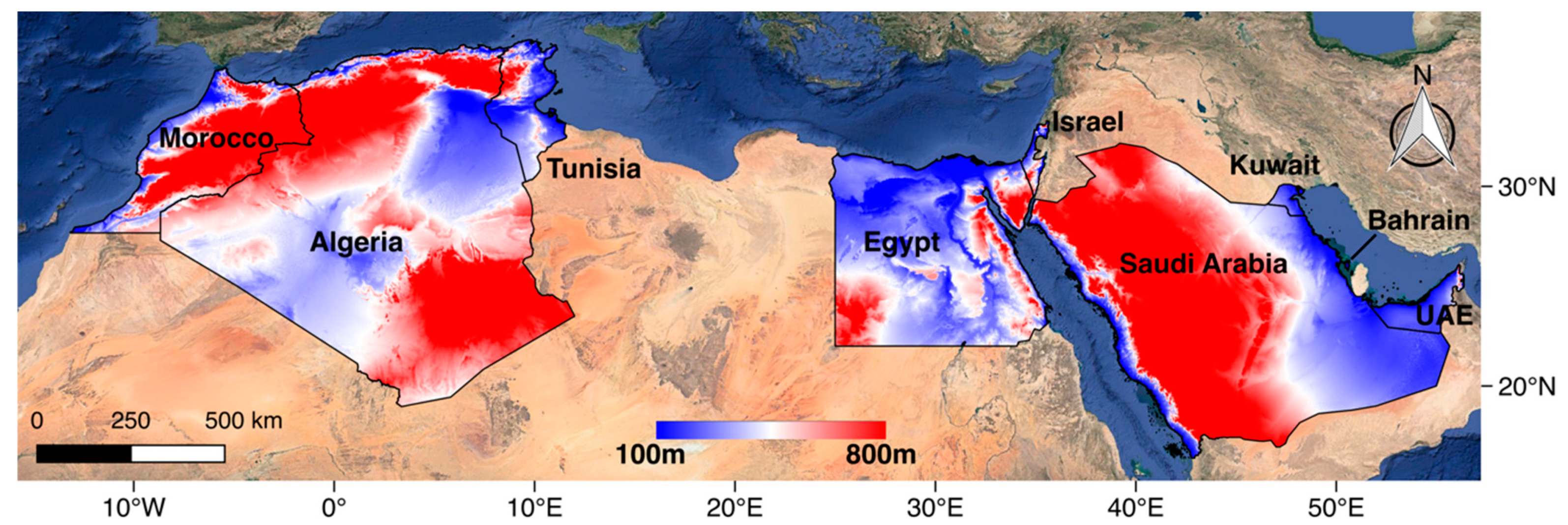
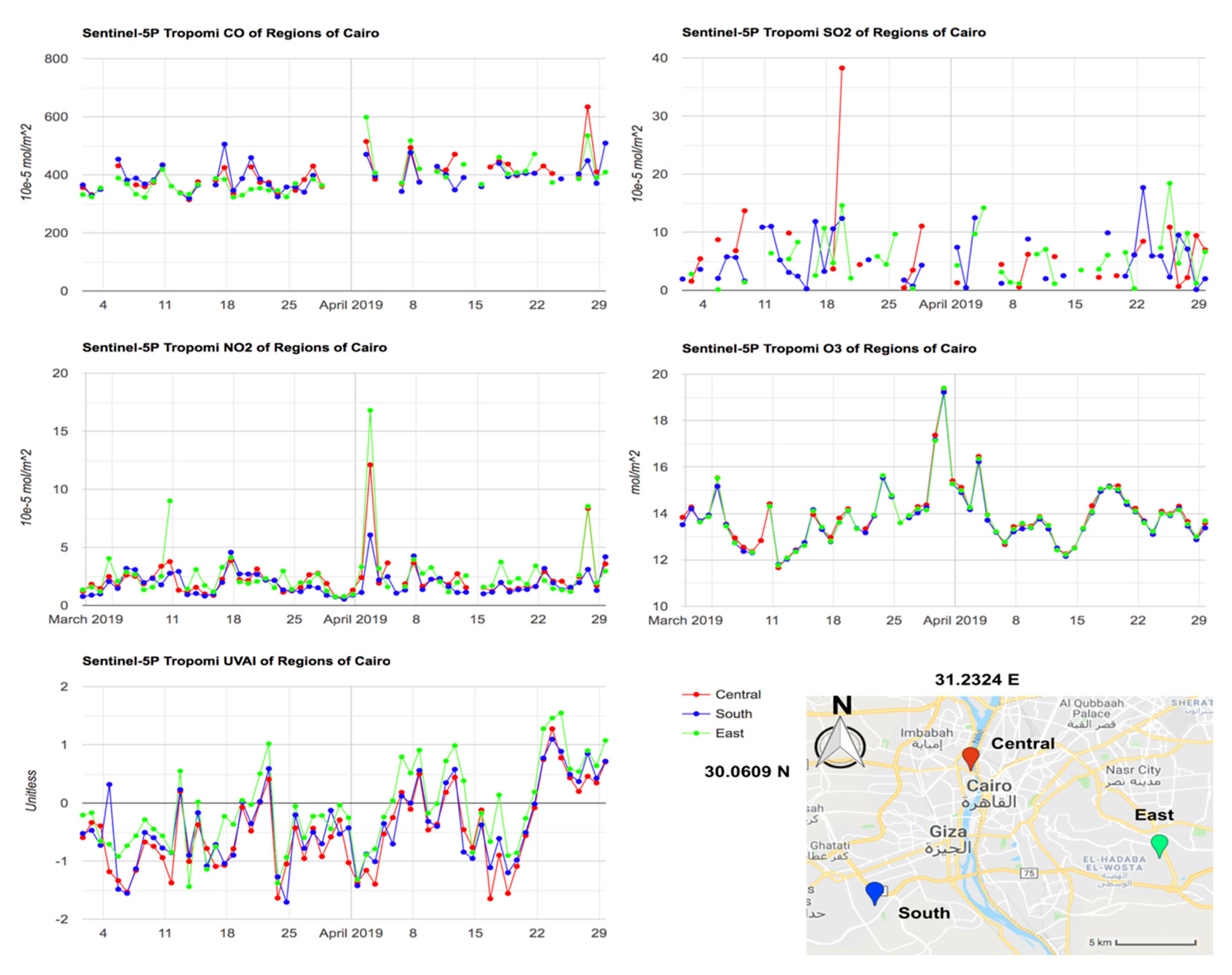
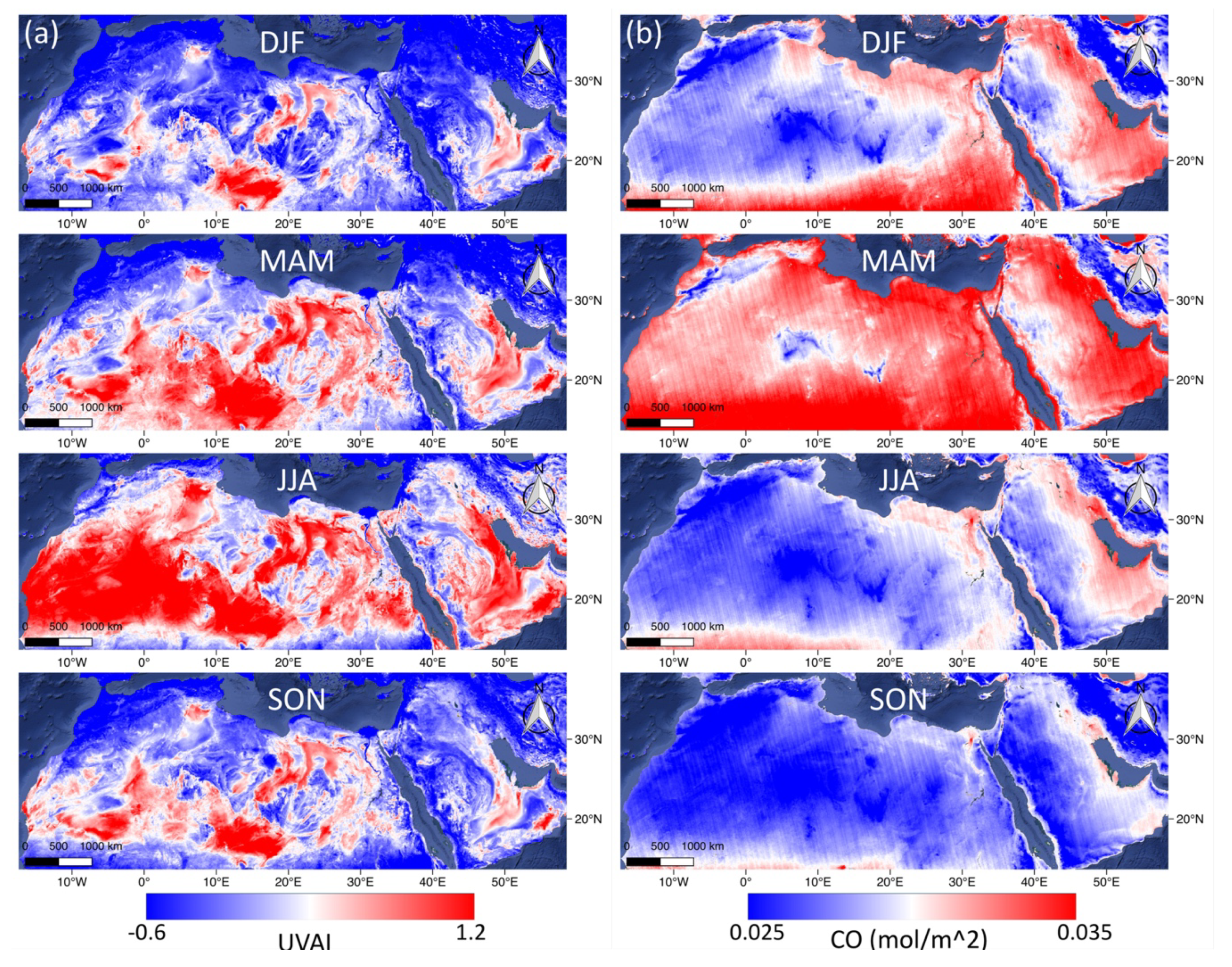
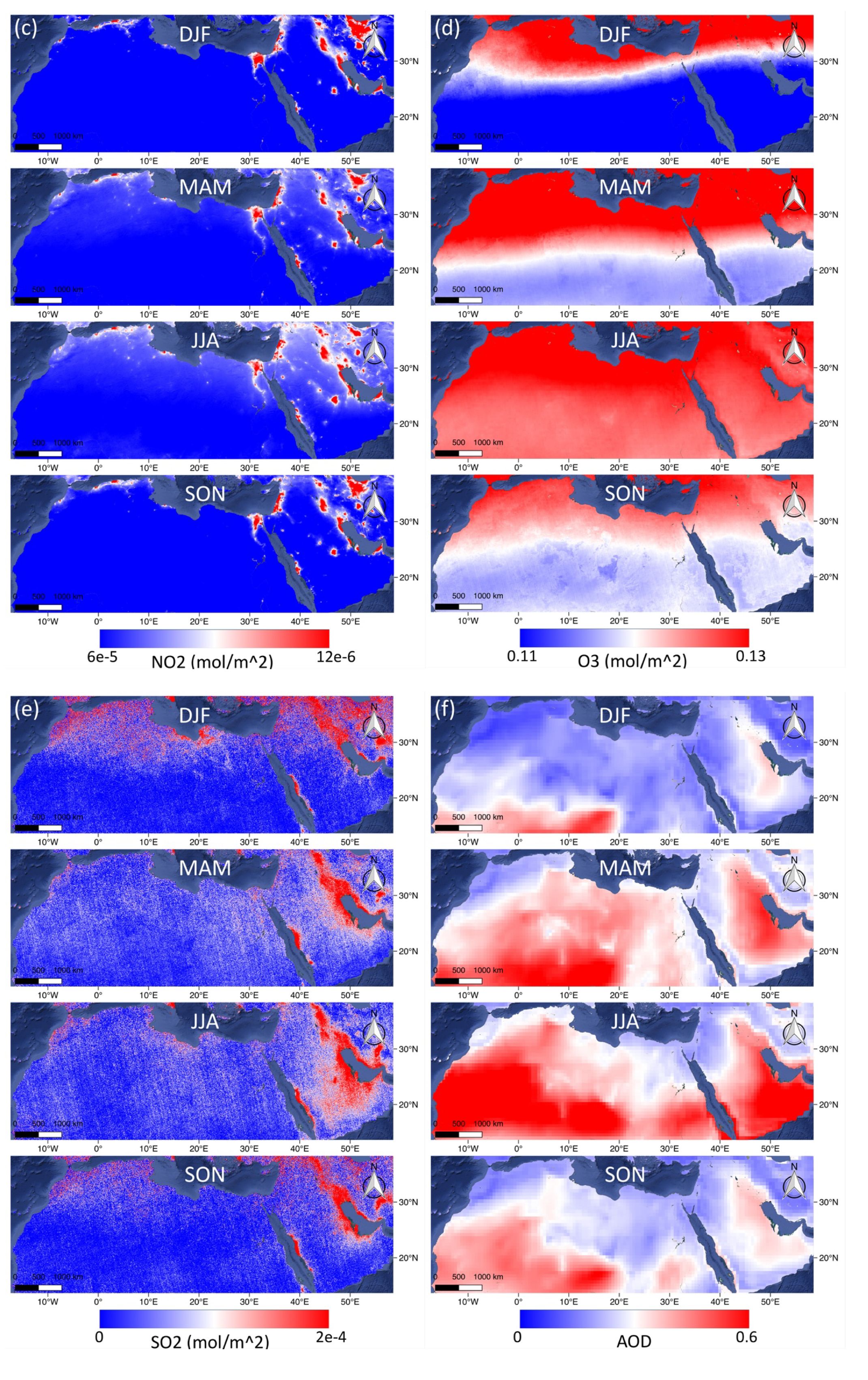
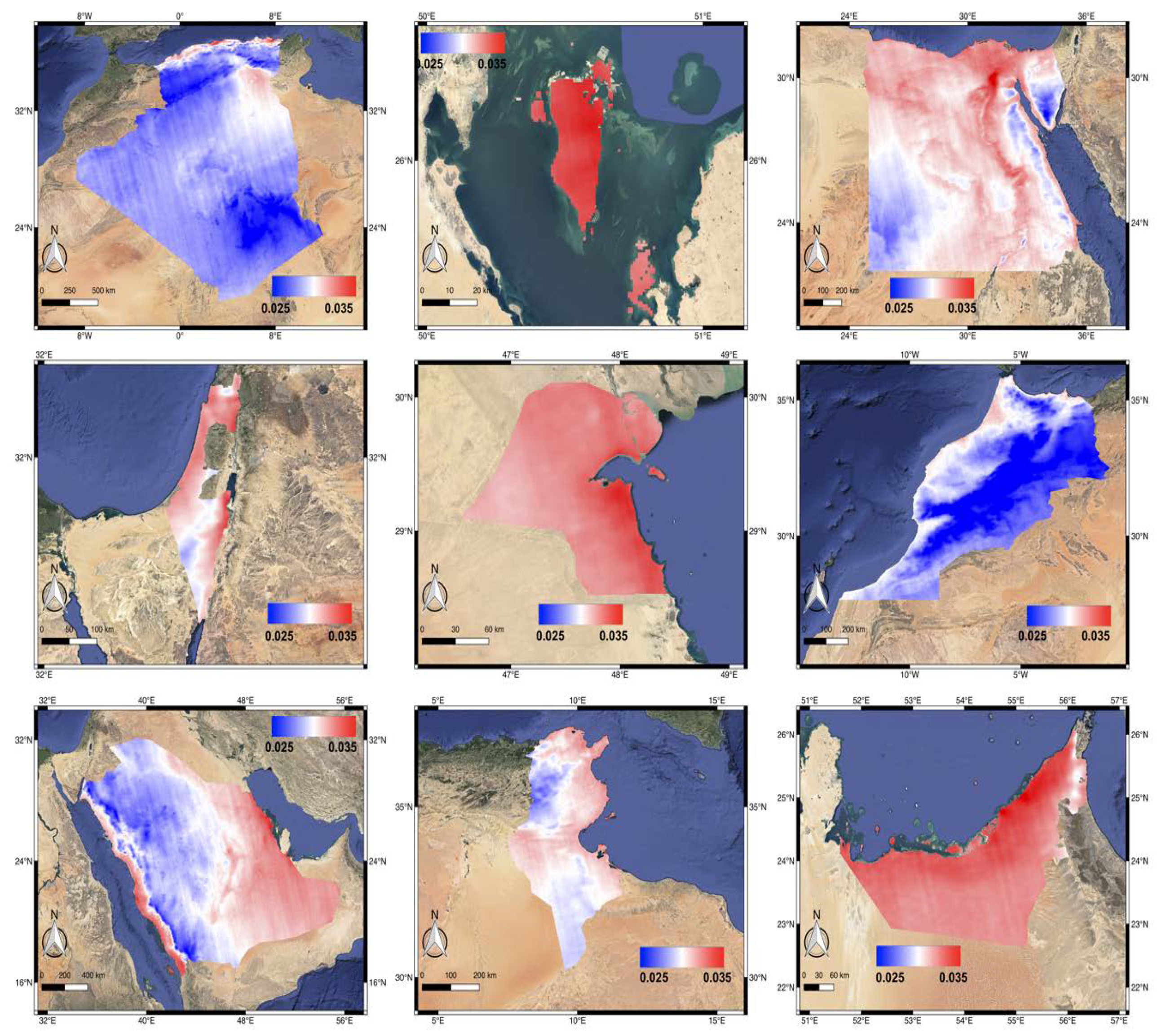
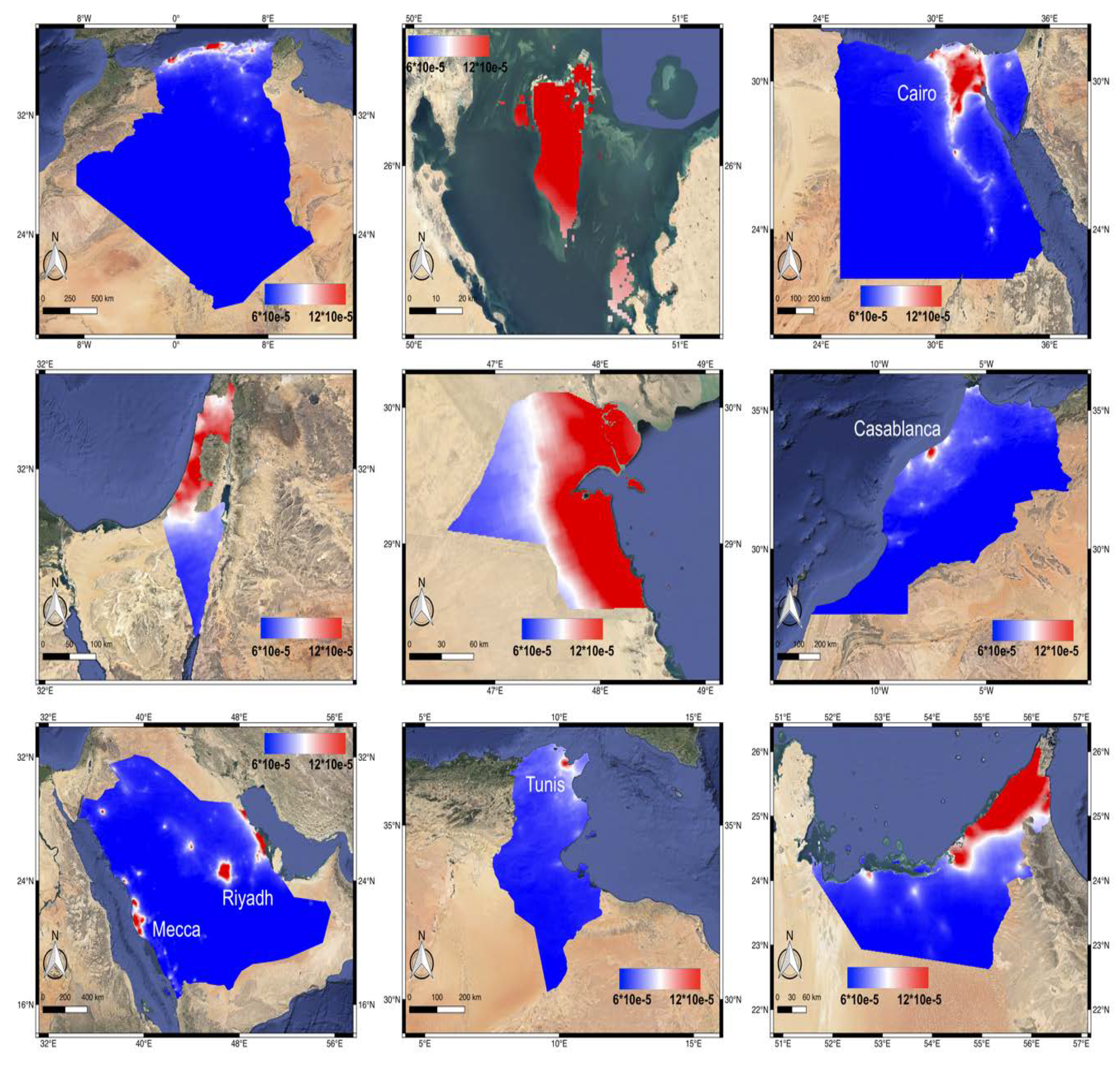

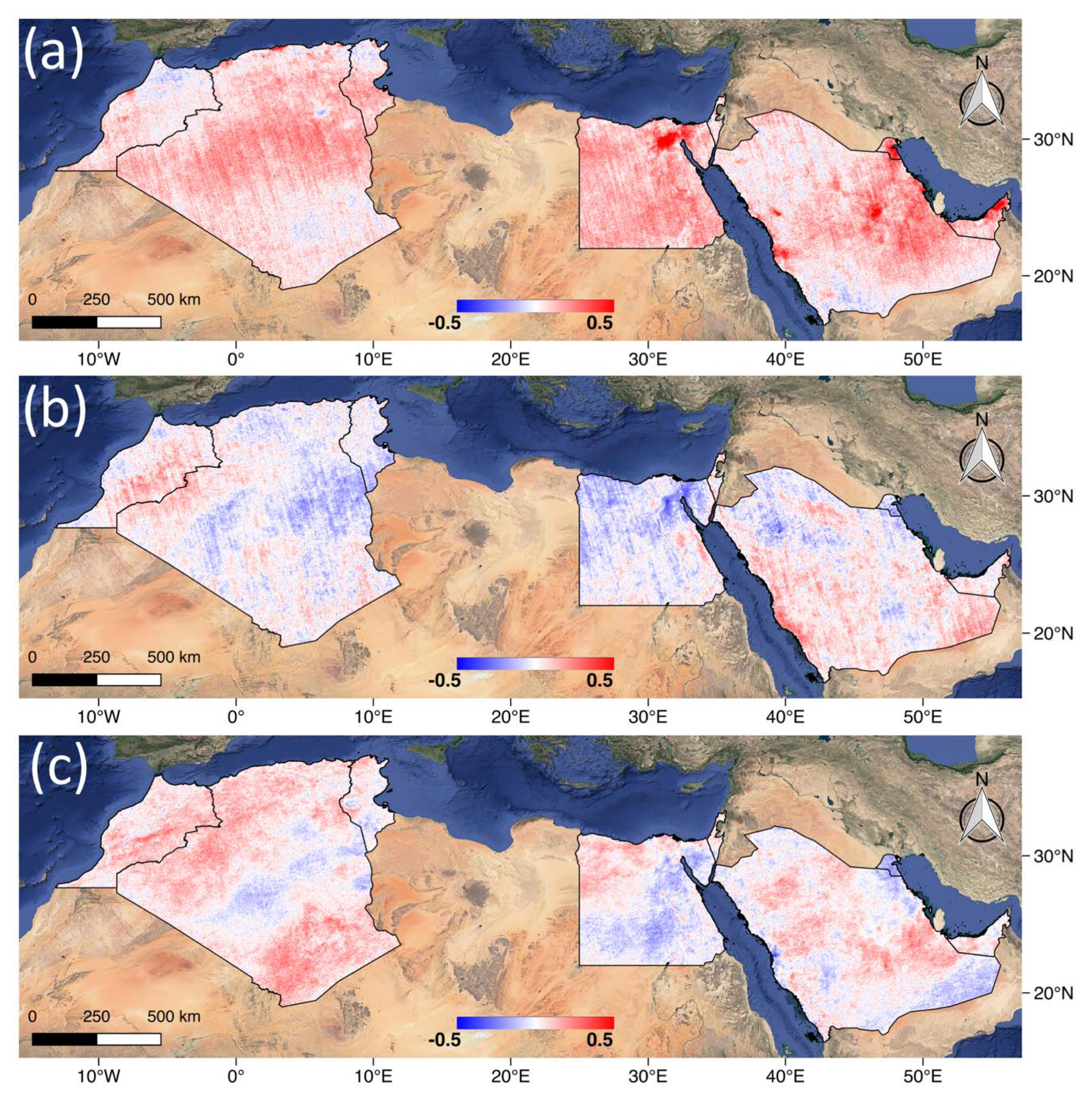
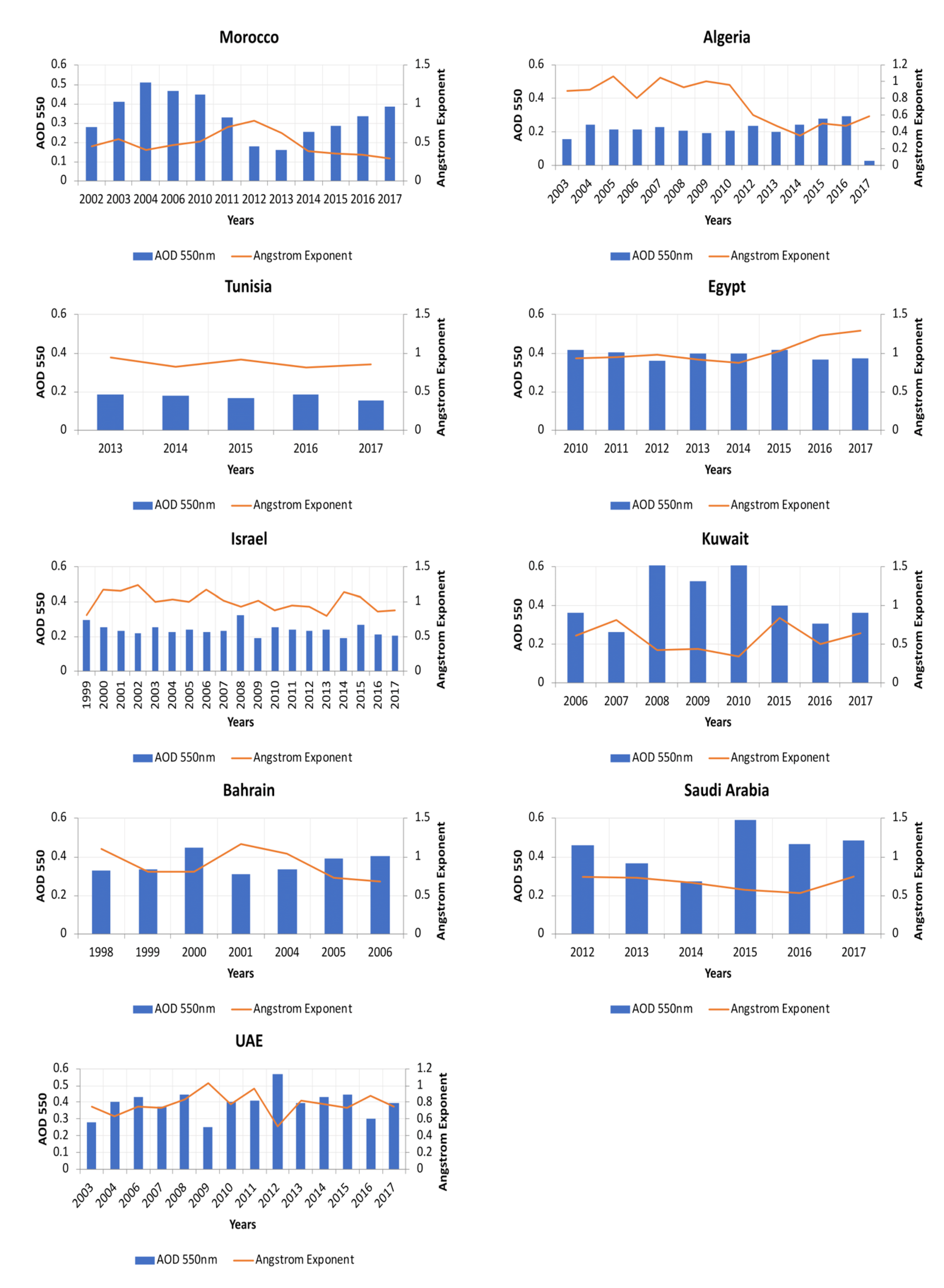
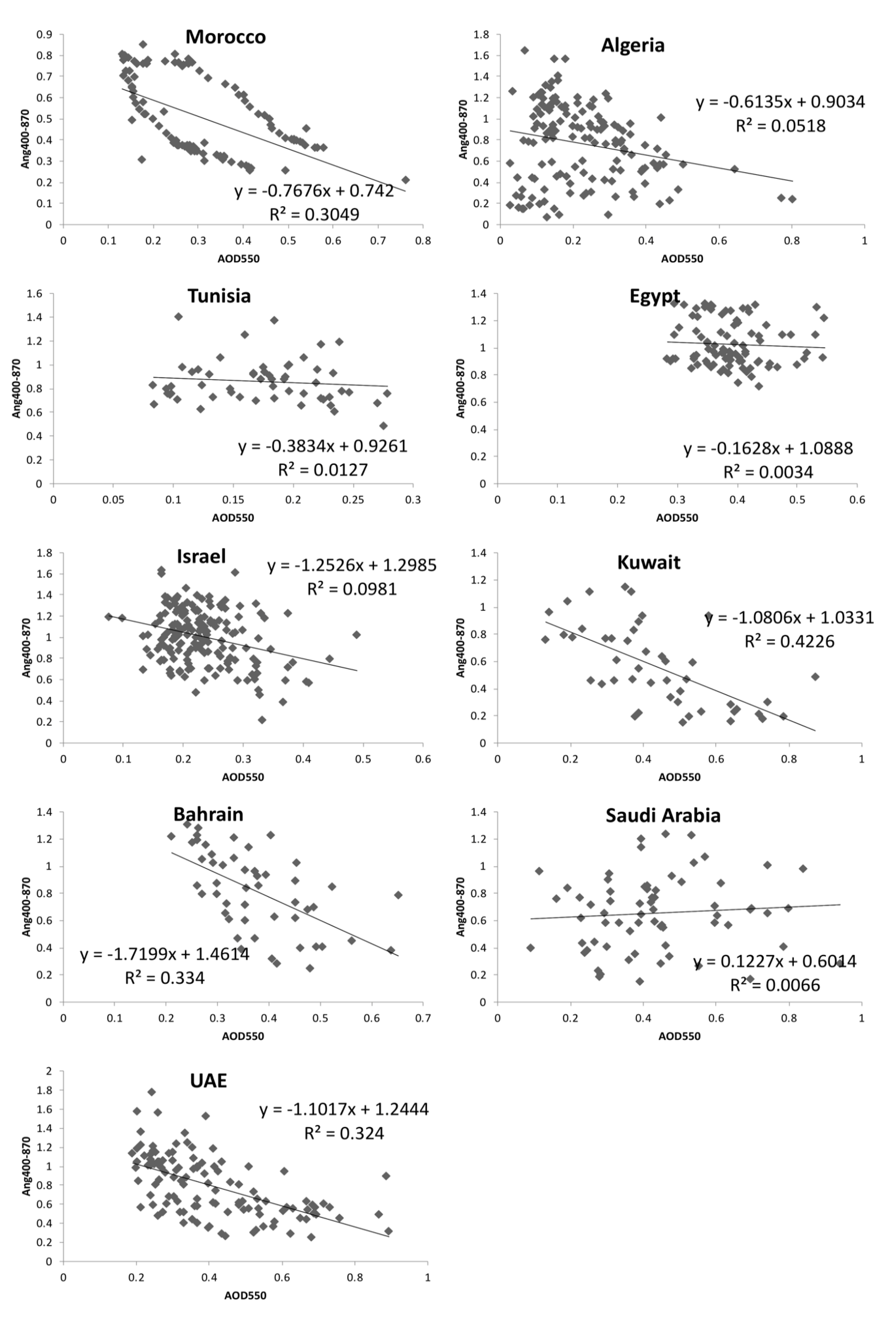
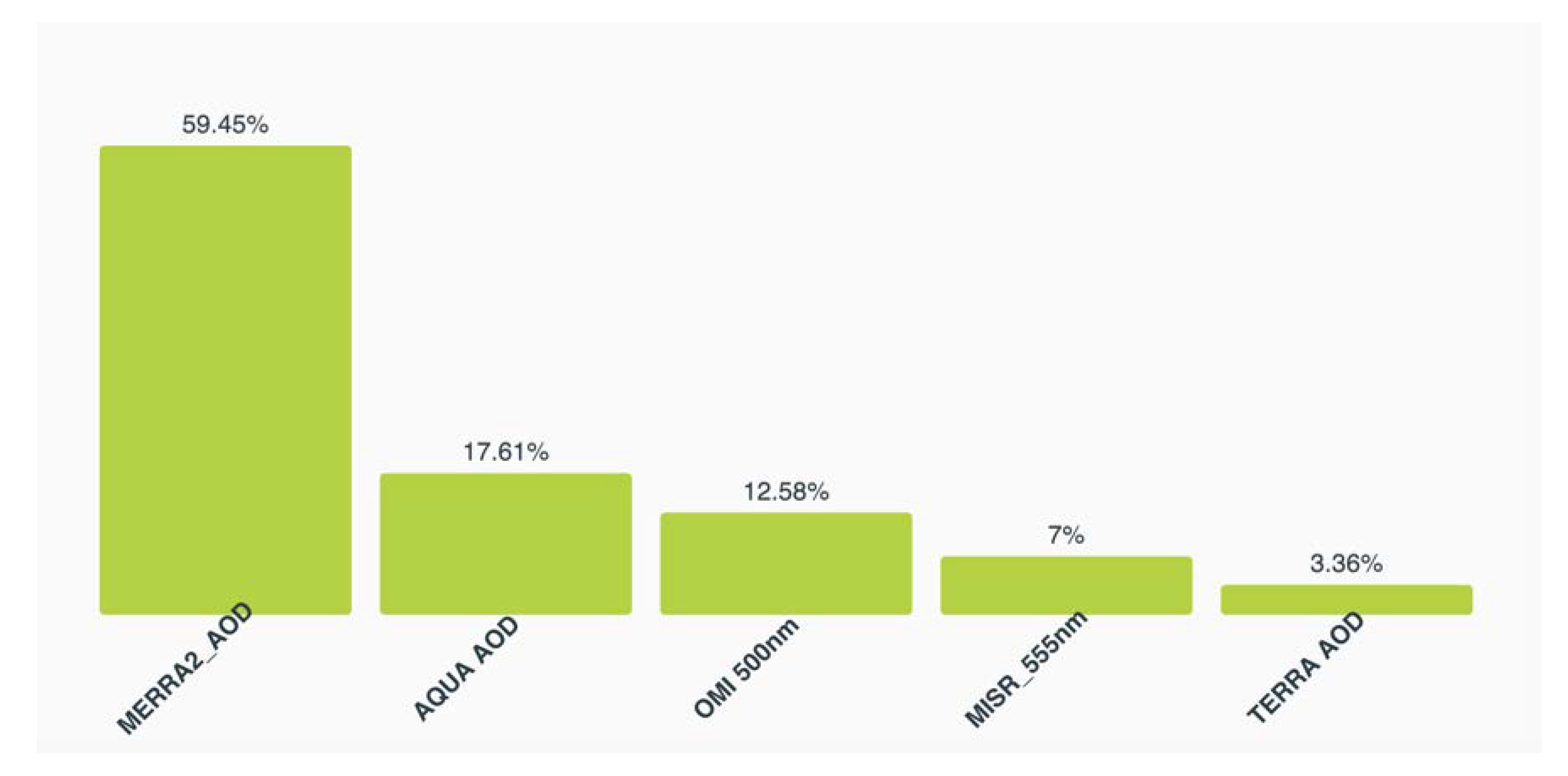
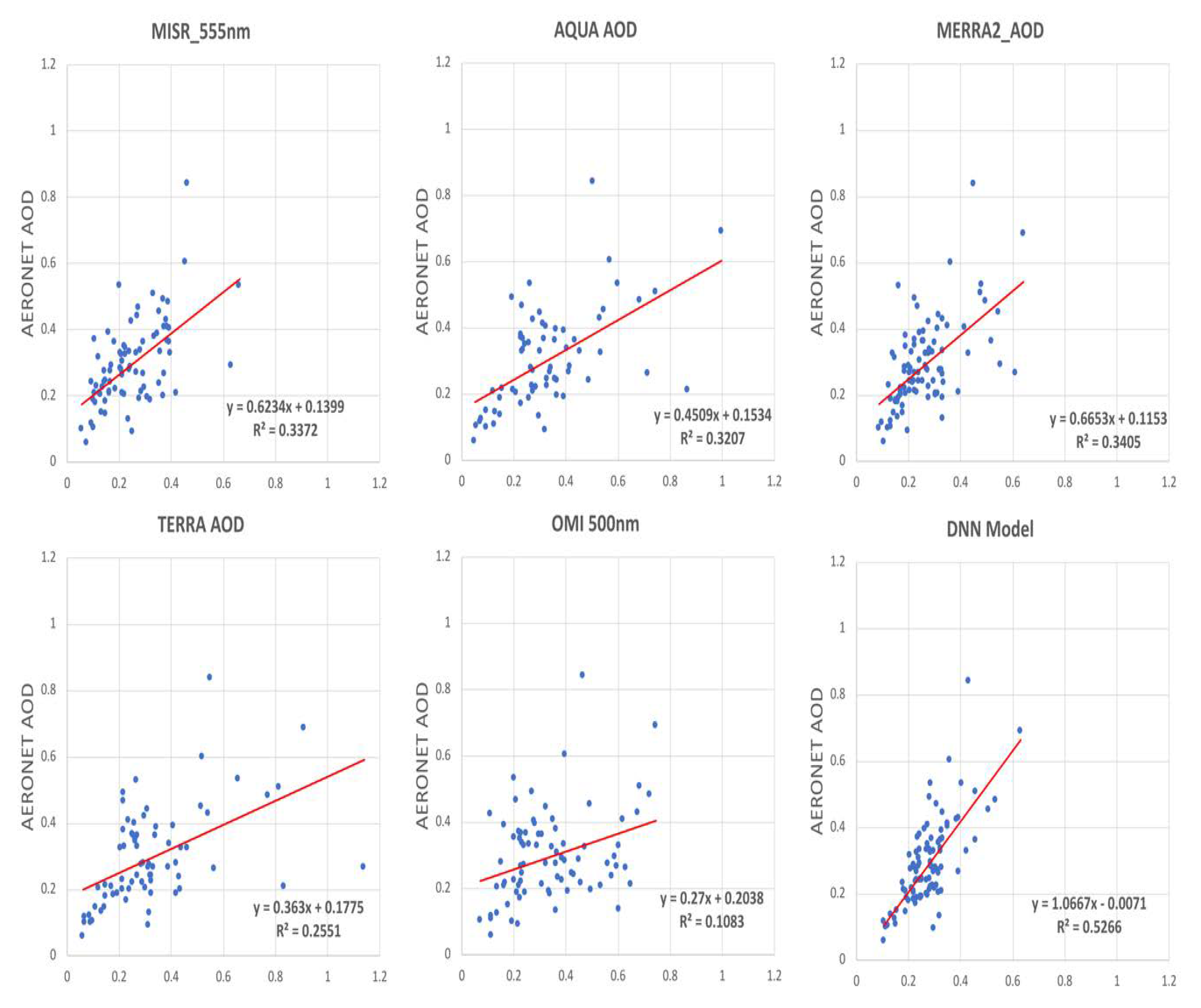
| Stations | Period of Available Data | Latitude | Longitude |
|---|---|---|---|
| Morocco (Dhakla) | February2012–December2017 | 23.717N | 15.950W |
| Tunisia (Ben salem) | June2013–December2017 | 35.551N | 9.914E |
| Algeria (Blida) | October2003–January2017 | 36.508N | 2.881E |
| Egypt (Cairo EMA) | April2010–December2017 | 30.081N | 31.290E |
| Israel (Nes-Ziona) | October1999–December2017 | 31.922N | 34.789E |
| Bahrain (Bahrain) | October1998–October2006 | 26.208N | 50.609E |
| Kuwait (Kuwait Airport) | June2006–December2017 | 29.325N | 47.971E |
| Saudi-Arabia (Solar Village) | February1999–May2013 | 24.907N | 43.397E |
| UAE (Dhabi) | October2003–August2017 | 24.476N | 54.329E |
| Country | Morocco | Algeria | Tunisia | Egypt | Israel | Kuwait | Bahrain | SA | UAE |
|---|---|---|---|---|---|---|---|---|---|
| Mean | 0.31 | 0.23 | 0.17 | 0.39 | 0.23 | 0.45 | 0.38 | 0.44 | 0.41 |
| N | 108 | 145 | 55 | 93 | 172 | 47 | 51 | 67 | 117 |
| STDEV | 0.13 | 0.14 | 0.05 | 0.06 | 0.07 | 0.18 | 0.10 | 0.18 | 0.17 |
| Upper | 0.33 | 0.25 | 0.19 | 0.40 | 0.24 | 0.50 | 0.40 | 0.48 | 0.44 |
| Lower | 0.28 | 0.20 | 0.16 | 0.38 | 0.22 | 0.40 | 0.35 | 0.39 | 0.38 |
| CI | 0.28–0.33 | 0.20–0.24 | 0.16–0.18 | 0.37–0.40 | 0.22–0.24 | 0.39–0.49 | 0.34–0.40 | 0.39–0.47 | 0.37–0.43 |
| Country | Morocco | Algeria | Tunisia | Egypt | Israel | Kuwait | Bahrain | SA | UAE |
|---|---|---|---|---|---|---|---|---|---|
| Mean | 0.51 | 0.76 | 0.86 | 1.03 | 1.01 | 0.55 | 0.82 | 0.65 | 0.78 |
| N | 108 | 145 | 55 | 93 | 172 | 47 | 51 | 67 | 124 |
| STDEV | 0.18 | 0.37 | 0.18 | 0.16 | 0.26 | 0.30 | 0.30 | 0.27 | 0.32 |
| Upper | 0.54 | 0.82 | 0.91 | 1.06 | 1.04 | 0.64 | 0.90 | 0.72 | 0.84 |
| Lower | 0.47 | 0.70 | 0.81 | 0.99 | 0.97 | 0.46 | 0.74 | 0.59 | 0.72 |
| CI | 0.47–0.53 | 0.70–082 | 0.81–0.90 | 0.99–1.05 | 0.96–1.04 | 0.46–0.63 | 0.73–0.89 | 0.58–0.71 | 0.72–0.83 |
| Ranking | Algorithm Name | R Squared | MAE |
|---|---|---|---|
| 1 | Deep Neural Network | 0.62628 | 0.06399 |
| 2 | Random Decision Forest | 0.55997 | 0.07530 |
| 3 | Linear Regression | 0.35081 | 0.08013 |
| 4 | Decision Tree | 0.24346 | 0.08129 |
© 2019 by the authors. Licensee MDPI, Basel, Switzerland. This article is an open access article distributed under the terms and conditions of the Creative Commons Attribution (CC BY) license (http://creativecommons.org/licenses/by/4.0/).
Share and Cite
El-Nadry, M.; Li, W.; El-Askary, H.; Awad, M.A.; Mostafa, A.R. Urban Health Related Air Quality Indicators over the Middle East and North Africa Countries Using Multiple Satellites and AERONET Data. Remote Sens. 2019, 11, 2096. https://doi.org/10.3390/rs11182096
El-Nadry M, Li W, El-Askary H, Awad MA, Mostafa AR. Urban Health Related Air Quality Indicators over the Middle East and North Africa Countries Using Multiple Satellites and AERONET Data. Remote Sensing. 2019; 11(18):2096. https://doi.org/10.3390/rs11182096
Chicago/Turabian StyleEl-Nadry, Maram, Wenzhao Li, Hesham El-Askary, Mohamed A. Awad, and Alaa Ramadan Mostafa. 2019. "Urban Health Related Air Quality Indicators over the Middle East and North Africa Countries Using Multiple Satellites and AERONET Data" Remote Sensing 11, no. 18: 2096. https://doi.org/10.3390/rs11182096
APA StyleEl-Nadry, M., Li, W., El-Askary, H., Awad, M. A., & Mostafa, A. R. (2019). Urban Health Related Air Quality Indicators over the Middle East and North Africa Countries Using Multiple Satellites and AERONET Data. Remote Sensing, 11(18), 2096. https://doi.org/10.3390/rs11182096





